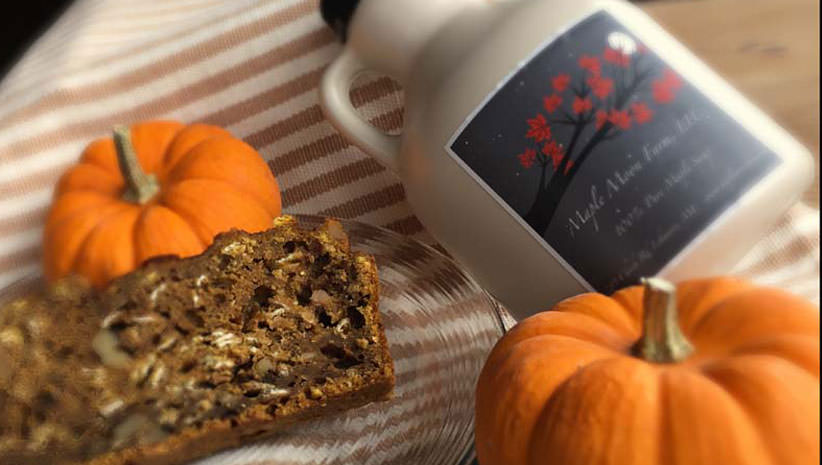
Maple Syrup Photo by Susan Currie
“Each beginning is the end of a waiting. We are each given exactly one chance to be. Each of us is both impossible and inevitable. Every replete tree was first a seed that waited.” —Hope Jahren, Lab Girl
When I need to recover my sanity or steady myself, I call for my canine soulmate, Tug, and head out into the woods. Something deep within compels me to do this, and almost immediately and unconsciously, my whole being slows down and I am drawn in to the folds of my surroundings.
Sometimes it is just a single tree that is required to work its healing magic on me. I lay at the base of a tree and peer up through the branches— this is an unusual and glorious perspective. In the fall, from this vantage point, I watch the leaves float down around me, wondering just how long I’d have to stay there until I was completely covered or which leaf will be the last to remain on the tree.
In the late winter through early spring, the dry brown leaves of beech trees still rattle against one another in the breeze, heroically clinging to their branches months after all the other leaves have fallen to the ground. I cannot resist running my hand over stumps and fallen logs that have become impossibly lush and furry with green moss. The spongy forest floor creates a spring in my step, and tempts me to fling myself to the ground in a sunny spot for a lengthy nap. The bark of the paper birch glows white against a backdrop of brown and grey trunks as well as the combination of colors in the evergreens. On occasion, I am moved to throw my arms around the oldest of trees—knotty and gnarly, twisted with age, replete with grace, dignity, and quiet wisdom. Oh, how I wish the trees could tell me their stories.
Sometimes I come across a comfortable seat that nature has put in my path: a broad flat stump, or a low branch that beckons me to come sit a spell in stillness. When I am in the woods, I remember what the earth smells like and how the air feels on my skin.
Looking at the trees around me, varying widely in size, shape, and other features, I am reminded of the slow and steady process of development. How very long it takes us all, trees and humans alike, to become what we are meant to be. I ponder the drastically changing outward appearance of trees through the seasons and over the years, and note that whether showy or unadorned, grand or humble, the elegant and arduous processes of life march on ceaselessly. I marvel at the faith each seed has demonstrated, the risk it has taken in anchoring itself to a single location for the duration of its days—trusting that the universe will place within its reach all that it needs to survive and thrive, and trusting in itself to make good use of the resources provided.
In recent years, I have become particularly enamored of the maple tree. My husband and I own a small commercial maple sugaring operation in southern Maine (Maple Moon Farm), and one of my favorite days of the year comes toward the end of winter when it is time to start tapping the maple trees. Under brilliant blue skies, I place a tap in the small hole I’ve drilled in each tree, and hang a metal bucket off the tap. If the temperatures are above freezing, the sap often starts to run immediately, and the “ping” of sap droplets hitting the bottom of the buckets becomes music that fills my ears from all directions.
I continue my work among a chorus of “pings,” feeling lucky to spend much of my days this time of year outdoors, absorbing nature’s lessons.
To ensure the continued health of the trees on our property, we must adhere to strict guidelines regarding the number of taps a tree of a particular size can accommodate. The ethos is to take as little as possible from your surroundings. As I look for a spot to place my next tap, I note evidence of taps from previous years; small holes in various stages of the healing process. It takes time, but eventually the trees neatly and nearly completely repair themselves, so that only a faint scar remains to tells an important story about a season in the life of the tree.
I approach the matriarch maple tree on our property, which is likely 200-300 years old. I observe the markings of larger, fully healed taps from generations ago and imagine sugar makers of years past standing in the very same spot using a brace and bit to insert an old wooden tap into the tree. I feel a palpable connection to the past. I greet the ancient tree as the dear friend she is and ask how she’s doing this year. I choose to place only a single tap in her trunk, though her substantial girth could easily accommodate several more. I give her a pat and say out loud, “Thank you old girl for sharing just a bit of your sap with us this season,” and move on with a heart full of gratitude for the treasures, hidden and apparent, that nature offers us in great abundance.
Jennifer Schultz is a Midwestern girl living in New England. She is happiest when living, working, and playing close to nature, and can frequently be found with her hands in the dirt at Maple Moon Farm: maplemoonfarm.com.
